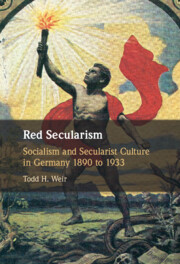Book contents
- Red Secularism
- Red Secularism
- Copyright page
- Contents
- Figures
- Tables
- Preface
- Abbreviations
- 1 Introducing Socialism and Secularism as Two Cultures
- 2 Secularist Culture in an Industrializing City
- 3 Prometheans
- 4 The Sociology and Psychology of Secularist Intellectuals
- 5 Workers and Worldview
- 6 The Politics of Secularism 1905–1914
- 7 Secularists in War and Revolution 1914–1922
- 8 Monism in the Weimar Workers’ Culture Movement
- 9 Culture War at the End of the Weimar Republic
- Epilogue
- Appendixes
- Archives Used
- Index
1 - Introducing Socialism and Secularism as Two Cultures
Published online by Cambridge University Press: 30 November 2023
- Red Secularism
- Red Secularism
- Copyright page
- Contents
- Figures
- Tables
- Preface
- Abbreviations
- 1 Introducing Socialism and Secularism as Two Cultures
- 2 Secularist Culture in an Industrializing City
- 3 Prometheans
- 4 The Sociology and Psychology of Secularist Intellectuals
- 5 Workers and Worldview
- 6 The Politics of Secularism 1905–1914
- 7 Secularists in War and Revolution 1914–1922
- 8 Monism in the Weimar Workers’ Culture Movement
- 9 Culture War at the End of the Weimar Republic
- Epilogue
- Appendixes
- Archives Used
- Index
Summary
Beginning in the late nineteenth century and lasting well into the Cold War, socialism represented the most powerful and sustained force of political and social dissent in Europe. Prior to the First World War, this dissent operated largely outside of the dominant order. Socialist political parties were excluded from participation in government and the industrial actions undertaken by labor unions were often met with violence and state repression. After the war, the socialist movement split into rival Social Democratic and Communist parties. The former entered government in many countries, while the latter contributed substantially to the political polarization that fed the emergence of authoritarian regimes across much of Europe.
Information
- Type
- Chapter
- Information
- Red SecularismSocialism and Secularist Culture in Germany 1890 to 1933, pp. 1 - 28Publisher: Cambridge University PressPrint publication year: 2023
